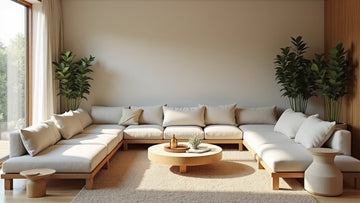Set up your open-plan living space for easy chats by putting furniture in round or half-round shapes. Keep seats 7-9 feet from each other to make talking feel natural.
Use soft lights that can go bright or dim to make the room feel warm. Pick art that gets people talking. Add plants, wood, and soft blankets to make it cozy.
Use rugs and smart furniture setup to mark the talking area. These steps will make a space where people want to gather and talk.
Key Takeaways
-
Define conversation zones using area rugs, furniture placement, and strategic seating arrangements to create distinct spaces within open floor plans.
-
Arrange furniture in circular or semi-circular configurations to encourage face-to-face interactions and facilitate natural communication.
-
Use multi-functional furniture like modular sofas and movable chairs to create flexible conversation areas that can adapt to different group sizes.
-
Layer lighting with dimmable fixtures and multiple sources to establish intimate and inviting conversation spaces that feel separate from surrounding areas.
-
Incorporate natural elements like plants, textured textiles, and accent pieces to make conversation areas feel welcoming and visually distinct from the surrounding open space.
Define Your Conversation Space
To make a good spot for talking in an open room, create a clear area that helps people feel relaxed and chat easily. The way you set up your furniture is important - it helps mark out the space and brings people together naturally. Put chairs and sofas in a circle or half-circle shape to make areas where people can talk face-to-face.
Using a rug on the floor helps show where the talking space begins and ends, making it stand out from other parts of the room. When you put furniture in the right spots and add careful design touches, you can turn an empty open space into a cozy meeting place that makes sense. Your main task is to build a space that works well and looks good at the same time.
Select Strategic Furniture Arrangements
In open living spaces, smart furniture placement turns empty areas into cozy spots where people can talk and spend time together. When you place your chairs and sofas with care, you make it easy for people to chat and connect.
Try these useful tips:
-
Put furniture in circles or squares so people can see each other
-
Keep seats 7-9 feet apart so talking feels natural
-
Mix different types of seating to make the space look good and work well
How your living room feels depends on where you put the furniture. Pick sofas, small couches, and chairs that fit well in your open space, and build around something special like a fireplace or eye-catching art. When you make clear spots for talking, you turn a big space into a cozy place where people want to gather and connect.
Layer Lighting for Ambiance
Lighting can change how a room feels, so it's important to use different types of lights in your open living space. Mix ceiling lights, wall lights, and table lamps to make each area special. Use dimmer switches to control brightness and match your needs.
Put lamps in corners and behind furniture to create soft light that makes people feel comfortable gathering together. Mix bright lights for reading or working with softer lamps on floors and tables - this makes spaces both useful and nice to look at. Add small lights to show off special walls or art pieces, which helps make your living space look planned and cozy.
Incorporate Meaningful Art Pieces
Art makes living spaces feel like special places where people want to talk and connect, rather than just rooms with furniture.
When choosing art for areas where people gather, pick pieces that mean something and help start conversations.
Try these tips:
-
Put interesting local art near seats to catch people's eyes and help them start talking
-
Pick art that matters to you and shows your life story - this helps make deeper connections
-
Change art pieces now and then to keep the room looking fresh and interesting
Add Natural Elements
Adding bits of nature like green plants and smooth stones helps turn plain rooms into lively spaces where people feel close to nature's peace. When setting up areas where people can talk easily, put seats in groups that help people face each other, like chairs around a coffee table with natural items on top.
Put plants near seating areas to make cozy, fresh spots. Using things like wool rugs and wooden tables helps make indoor spaces feel more like the outdoors. Adding stone drink holders, soft woven blankets, and small fountains creates a room that feels both nice and welcoming.
Create Flexible Seating Options
Flexible seating makes spaces where people can gather and talk easily. When you place furniture thoughtfully in living rooms and family rooms, you create spots that help people connect.
Try these simple ways to set up seating:
-
Mix different seats like sofas, comfy chairs, and footstools so people can sit how they want
-
Keep furniture pieces 7-9 feet apart near kitchen islands for easy talking
-
Put coffee tables in the middle to tie the space together and help start conversations
Balance Open and Intimate Zones
When creating open-plan rooms, it's key to make spaces that feel both big and cozy. Your main living area needs the right mix of open and private spots to fit groups while keeping each space comfortable. Place your furniture and use room features wisely to make clear talking areas within the bigger room.
Make a snug corner with two comfy chairs that feels more private but still connects to the main space. Use rugs, furniture sets, and light room dividers to mark different areas. This helps you build a space that works well for both group activities and quiet, private talks.
Frequently Asked Questions
How to Create a Conversational Living Room?
Set up your living room for good talks by putting seats close together, adding lights in the right spots, facing furniture so people can talk easily, using colors that work well together, and placing a nice rug to tie it all together.
How to Set up a Conversation Area?
Set up a nice conversation space by placing comfy seats in a circle or group, putting furniture around a main point of interest, and making sure people can walk around easily. Add good lighting to help people feel relaxed and talk better together.
How to Separate Areas in an Open Floor Plan?
Break up space in an open floor plan by using dividers like half-walls, well-placed furniture, and different lights to mark each area, making your space feel organized and separate while staying open.
What Is the Ideal Distance for Conversation Areas?
Keep seats 7-9 feet apart so people can talk easily and see each other well. This spacing helps everyone feel at ease and chat comfortably.
Conclusion
Transform your open-plan space into a dynamic conversation hub by thoughtfully integrating design elements. Our Timbur handcrafted furniture pieces help create strategic placement, while layered lighting and purposeful decor can create intimate zones within expansive areas. By balancing functionality with aesthetic appeal, you'll craft a space that invites connection, sparks dialogue, and reflects your unique style. Your living area isn't just a room—it's a canvas for meaningful interactions enhanced by the natural beauty of custom-made furniture.









